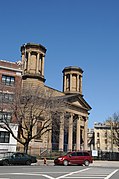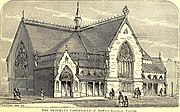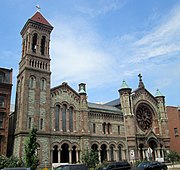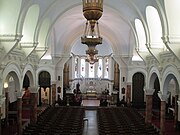-
High Street Presbyterian Church, Newark, New Jersey, 1850-52.
-
Newark Orphan Asylum, Newark, New Jersey, 1856-57.
-
Brooklyn Tabernacle, Brooklyn, New York, 1873-74.
-
Interior view of the Episcopal Church of St. Luke and St. Matthew, Brooklyn, New York, 1889-91.
-
All Saints Episcopal Church, Brooklyn, New York, 1892-93.
John Welch | |
|---|---|
| Born | March 13, 1825 |
| Died | November 21, 1894 (aged 69) |
| Nationality | American |
| Occupation | Architect |

John Welch (1825-1894) was a Scottish-born American architect of Brooklyn, New York, who designed numerous churches. He was one of the founders of American Institute of Architects. [1] [2]
Life and career
John Welch was born March 13, 1825, in Scotland, [3] and was trained in architecture in Scotland and England. [4] In 1849 he came to the United States, initially settling in Newark, New Jersey, where he opened his first office. [5] Welch soon became known as an architect of churches, and in 1857 was among those invited by Richard Upjohn to form the American Institute of Architects. [6] By 1862 Welch had relocated to Brooklyn, where he would live for the rest of his life. [7] Welch practiced architecture almost until his death, though he fell on hard times, financially, in the early 1890s and was obligated to work odd jobs for the last period of his life. [4]
Personal life
John Welch died November 21, 1894, while eating dinner in a Brooklyn restaurant. He was survived by his wife. Several notices of his death noted that he had been estranged from his family for several years and lived alone. [8] [4]
Legacy
The St. Luke's Protestant Episcopal Church in Brooklyn, designed and built by Welch during 1888–89, has been said to be "among the largest and finest of nineteenth-century ecclesiastical structures in New York City". [9] The second Brooklyn Tabernacle, which Welch designed for Thomas De Witt Talmage, was one of the first auditorium plan churches in the United States, a method of church design popularized by others as the Akron Plan. [8]
A number of his works are listed on the National Register of Historic Places. [10]
Works
- High Street Presbyterian Church (former), [a] 588 Dr Martin Luther King Jr Blvd, Newark, New Jersey (1850–52, NRHP 1972) [11]
- South Park Calvary United Presbyterian Church, 1035 Broad St, Newark, New Jersey (1853, NRHP 1972) [12]
- St. Paul M. E. Church, Newark, New Jersey (1853–54, demolished) [13]
- R. C. Cathedral of St. Paul, Grant St and Fifth Ave, Pittsburgh, Pennsylvania (1855, demolished) [14]
- Newark Orphan Asylum (former), [b] 323 Dr Martin Luther King Jr Blvd, Newark, New Jersey (1856–57, NRHP 1973) [15]
- 61st Street M. E. Church, 223 E 61st St, New York City (1873, demolished) [16]
- Brooklyn Tabernacle, Schermerhorn St, Brooklyn, New York (1873–74, burned 1889) [17]
- Peoples' Temple, 187 Columbus Ave, Boston, Massachusetts (1878, demolished) [18]
- Centenary Queen Square United Church, 95 Wentworth St, Saint John, New Brunswick, Canada (1878–82, demolished 2019) [19]
- 18th Street M. E. Church (former), 224 18th St, Brooklyn, New York (1882–83) [20]
- Janes M. E. Church, 660 Monroe St, Brooklyn, New York (1883, partially burned 1984) [21]
- First Baptist Church of Williamsburg, 103 Lee Ave, Brooklyn, New York (1884–85, demolished 2001) [22]
- Episcopal Church of St. Luke and St. Matthew, 520 Clinton Ave, Brooklyn, New York (1888–91, NRHP 1982) [9] [22]
- Sands Street Memorial M. E. Church, 70 Clark St, Brooklyn, New York (1889–91) [23]
- All Saints Episcopal Church, 286-288 Seventh Ave, Brooklyn, New York (1892–93) [22]
Gallery of works
Notes
- ^ Since 1945 this building has been home to St. James' A. M. E. Church.
- ^ Now Eberhardt Hall, New Jersey Institute of Technology.
References
- ^ "Eberhardt Hall - Restored" (PDF). NJIT. 2006. Archived from the original (PDF) on 2011-07-20.
- ^ "NJIT To Receive Honor from Newark Preservation Committee for Eberhardt Hall Restoration". NJIT. 2006-03-02.
- ^ Gravestone, Green-Wood Cemetery, Brooklyn
- ^ a b c "Obituary" in Architecture and Building 21, no. 21 (November 24, 1894): 252.
- ^ Carole Rifkind and Carol Levine, Mansions, Mills and Main Streets (Schocken Books, 1975)
- ^ Everard M. Upjohn, Richard Upjohn: Architect and Churchman (New York: Columbia University Press, 1939)
- ^ Brooklyn directories
- ^ a b "Architect John Welch's Sudden Death" in New York Times, November 22, 1894, 1.
- ^ a b Andrew S. Dolkart and Anne B. Covell (June 1981). "National Register of Historic Places Registration:St. Luke's Protestant Episcopal Church". New York State Office of Parks, Recreation and Historic Preservation. Archived from the original on 2012-10-19. Retrieved 2011-02-20. See also: "Accompanying seven photos". Archived from the original on 2012-10-19.
- ^ "National Register Information System". National Register of Historic Places. National Park Service. July 9, 2010.
- ^ St. James' A. M. E. Church NRHP Registration Form (1972)
- ^ South Park Calvary United Presbyterian Church NRHP Registration Form (1972)
- ^ Record of the Twenty-fifth Anniversary of St. Paul's M. E. Church, Newark, N. J. (Newark: St. Paul's M. E. Church, 1878)
- ^ Bryan Regan, Gothic Pride: The Story of Building a Great Cathedral in Newark (New Brunswick: Rivergate Books, 2012)
- ^ Newark Orphan Asylum NRHP Registration Form (1973)
- ^ Real Estate Record and Builders Guide 12, no. 292 (October 18, 1873): 478.
- ^ Anne C. Loveland and Otis B. Wheeler, From Meeting House to Megachurch: A Material and Cultural History (Columbia: University of Missouri Press, 2003)
- ^ Building News 34, (May 24, 1878): 520.
- ^ "Victim of neglect and apathy, an iconic Saint John building comes to a sad end".
- ^ Real Estate Record and Builders Guide 29, no. 744 (June 17, 1882): 611.
- ^ Sanitary Engineer 8, no. 17 (September 27, 1883): 403.
- ^ a b c Church of St. Luke and St. Matthew NYCL Designation Report (1981)
- ^ American Architect and Building News 39, no. 895 (February 18, 1893): 110.






